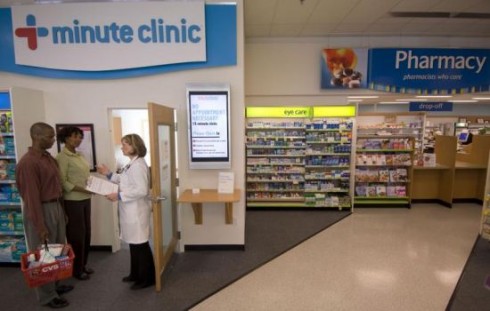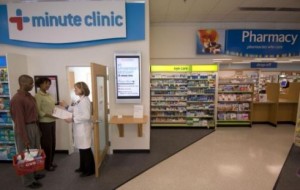“Wow – unbelievable! I was the first in line – from start to finish, total of about 8 minutes. Getting my prescription 10 feet away right now for a sinus infection. Ebony was the nurse practioner. Very nice, a model of efficiency.” – CVS MinuteClinic review on Yelp
How can a small, one-room “clinic” in a drugstore staffed by a single nurse practitioner get glowing reviews while state-of-the art medical facilities struggle with patient satisfaction? The answer is simple: retail clinics leverage the Value Adding Process (VAP) business model to achieve fast, consistent, affordable care outcomes that elude businesses models bound by complexity.
How VAP businesses create efficiency and standardize outcomes
While the Solution Shop business model employs highly-trained experts to solve undefined problems, a VAP business begins with a defined problem with consistent inputs and then, through consistent processes, delivers consistent results.
How does this model play out in MinuteClinic? First, they standardize inputs. CVS advertises the specific conditions that they treat, and they decline to treat any others. In this way, they encourage a well-defined subset of patients to visit. If a person has a powerful sore throat, pustules, a fever, and other tell-tail signs of a strep infection, that person would consider visiting MinuteClinic.
Second, they use consistent processes to treat conditions. They diagnoses and treat diseases in the realm of precision medicine such as strep throat that are well-understood and easily diagnosed. A person goes in and gets a throat swab for a fast-culture strep test. If the test comes back positive, the person gets a prescription for antibiotics shown to effectively treat the disease. These consistent processes enable retail clinics to primarily employ nurse practitioners instead of very expensive doctors who would be underutilized treating only well-defined conditions.
Finally, due to consistent inputs with defined procedures, MinuteClinic can deliver consistent health outcomes. Because of their consistency, instead of charging by time, MinuteClinic charges by outcome –each procedure has a set cost, often much lower than that of a hospital or general clinic. Despite lower costs, RAND has reported that retail clinic quality-of-care scores are comparable to more conventional settings.
Creating successful VAP businesses
Despite lower costs and equal if not higher quality care, retail clinics and other VAP businesses such as some specialty hospitals and surgery centers have provoked criticism from other care providers. Competitive backlash has resulted in slow approval for retail clinic operations, constraints on nurse practitioner scope-of-practice, and complaints that specialty centers steal profitable procedures and healthy patients. This backlash can reach devastating proportions: the Affordable Care Act in 2010 banned new specialty hospitals and prohibited investment in existing ones, crippling the industry.
We offer three suggestions for health care innovators who wish to improve health care by opening VAP businesses.
- Augment, rather than directly compete with, incumbent players. Specialty hospitals billed themselves as alternatives to the general hospital, understandably provoking widespread backlash. Venture capitalists love the businesses that promise to take out the inefficient old boys, but these type of ventures rarely survive the resultant backlash. Some retail clinics, instead of directly competing, are acting as referral sources and offering services complimentary to traditional providers. Walgreens, for example, is partnering with local hospitals to provide coordinated care.
- Do not mix business models. Every business is tempted to “do it all,” but the VAP business model specifically gains its power from doing a well-defined subset of procedures very well. In health care, any procedure with consistent results that can be coupled with consistent patient inputs (potentially via disruptive precision diagnostics) is a potential candidate for inclusion in a VAP business. Despite this wide field, many potential health care businesses do not significantly lower care costs or improve accessibility because they do not remain true to the business model. Many ambulatory surgery centers are somewhat lower cost than hospitals, but they do not reach their full cost-saving potential because they commingle intuitive, complex surgery with defined, well-understood procedures. Any who mix business models risk becoming like the ailing general hospital that must ultimately give way to more adept, focused competition.
- Wisely adopt simplifying technology, but beware of overinvesting. MinuteClinic customers have a precise job-to-be-done: fix me as quickly and cheaply as possible. Technologies that aid patients in accomplishing this job will lead to satisfaction. MinuteClinic has effectively used electronic medical records that guide practitioners in diagnosis and treatment for some time. Other technologies, such as expensive imaging machines, may be tempting because they would allow the practitioners to diagnose a wider range of ailments. This technology investment would dangerous, however, because it would increase the cost of care while not enabling faster treatment.
VAP businesses that remain true to their models and follow these recommendations will help to create a health care system that is more affordable and accessible. Profitable opportunities abound. Executed correctly, customers will echo the reviewer above: “Wow – unbelievable!”



